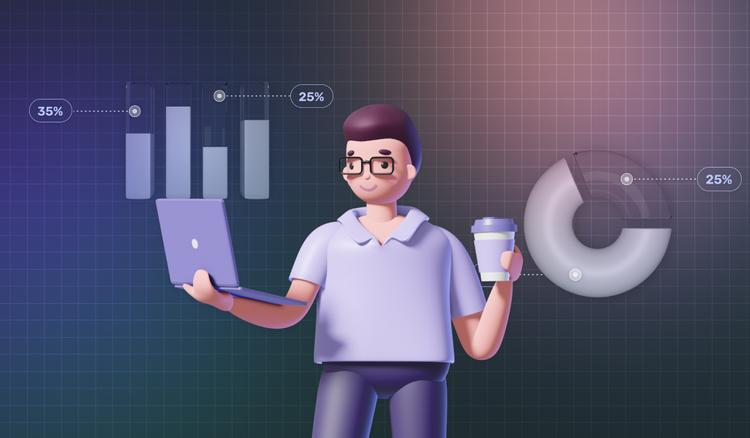If you are only making the first steps in your software development journey, it’s really hard to decide what type of app will work best for your business. No worries, we’ve all been there.
In this ultimate guide, we’ll introduce you to everything you need to know about progressive web apps and native apps. Additionally, we’ll tackle PWA vs native pros and cons, so that you can choose the optimal approach for your needs and requirements.
But first things first. Before starting a battle “PWA vs a native mobile app”, let’s make sure that you have a clear understanding of both application types.
What is a progressive web application?
A progressive web application, abbreviated as PWA, is not a typical app in the conventional sense. It is an app-imitating website designed and optimized to perform like a mobile application. In other words, PWAs are more user-friendly than traditional web pages, but you don’t need to download them from app stores. It’s enough to find them through browsers and use them right away.
We know, it’s better to see once than to read the definition over and over again. By way of illustration, check out Spotify or Starbucks websites from your mobile device. These two are nice examples of PWAs in action.
Want to see some web app examples? See this nice list by My Codeless Website
What is a native application?
The term native app speaks for itself, as it is natively developed to run on a specific platform, iOS or Android, and to ensure outstanding adaptability and great user experience. When considering a career as an iOS developer, it’s essential to grasp the significance of this platform-specific approach. Whatever you choose – Android or iOS app development, your app will have a non-reusable codebase. In the case of native apps, you don’t need to go far for example – a calculator or a weather app originally installed on your device are native ones.
Below, we’ve highlighted the main PWA vs native mobile app differentiators.
Pros of a PWA
1. Universal compatibility
The main difference between a progressive web app and a native app is that PWAs adapt to various operating systems and screen sizes. Unlike native apps, you can open a PWA on iOS, Android, Windows, or any OS – they will offer a great user experience regardless of the device.
2. Development cost
As mentioned earlier, a PWA can run across multiple operating systems. This eliminates the need to write separate codebases and consider OS-specific functionality. It’s enough to develop a single codebase which is indeed less time-consuming and more budget-friendly.
3. App-like experience
For a user, PWAs look and feel like ordinary mobile applications. PWAs can send push notifications (currently available for Android only) and don’t require any app updates since they are already connected to the web. Using a PWA means that you are tuned to the latest app version.
4. Visibility by search engines
Progressive web apps are indexed by Google algorithms and can be found online. What does it mean for your business? You can SEO-optimize PWAs as usual websites to engage customers through organic search and learn from SEO rivals to boost your credibility.
5. No installation required
The availability of instant use is an obvious advantage of PWAs. Let’s be crystal clear, users don’t like to wait. Since PWAs are not presented in app stores, users don’t need to find an app and wait till it’s downloaded and installed.
6. No moderation needed
Another bonus of PWA’s absence in app stores is the lack of necessity to go through moderation. As you know, each native app should be reviewed for compliance with technical requirements and guidelines before publishing. This process may be delayed, and even worse – your native application may not be published at all. However, this won’t happen to a PWA.
Here, using a bootstrap admin dashboard template can streamline PWA development, providing responsive design and modern components to enhance performance and user experience across devices.
Cons of a PWA
1. Limited offline use
If you’ve already done some research about PWAs, you’re probably aware that they actually can work in the offline mode. That’s true but to a limited extent as PWAs still depend on the web browser connection. How so?
From a technical perspective, it is possible due to service workers (special Javascript files operating in a separate browser thread) and their caching functions. When a user is browsing your PWA, the seen web pages get cached. If the Internet connection is unavailable, the user can still access and navigate the cashed pages, but not the entire PWA functionality.
2. A limited set of features
Compared to native apps, progressive web applications have limited access to the device functionality. For instance, PWAs can’t use your contacts or support Bluetooth and NFC. In some domains, it can be a huge roadblock on the way to delivering a decent user experience.
3. Use of device battery
PWAs drain more battery in comparison with native apps. Progressive web apps are developed in JavaScript and use the Internet connection which makes them more energy-consuming for smart devices.
Pros of native apps
1. Supreme performance
Outstanding user experience is the main “calling card” of native applications. Such apps are built according to the technical requirements of a certain platform, iOS or Android. As such, making use of a native programming language and APIs guarantees that an app will perfectly match the platform, demonstrating flawless usability and seamless UX/UI. Plus, with native app development, you can be more creative when it comes to in-app functionality and add the most sophisticated features to your product.
2. High level of interaction
If you’re planning to build a mobile app that should have direct fail-safe access to a camera, microphone, or Bluetooth, native app development is the only right option. Native applications can leverage smartphone hardware as well as interact with other native apps without boundaries. By contrast, implementing these capabilities for a PWA may become a challenging or even impossible mission.
3. Monetization
Have an app monetization strategy on your agenda? If the answer is positive, go for native app development. Due to the fact that native applications are published in the app stores, you can easily integrate in-app purchases and payment processing via the app store. Those who plan to monetize PWAs should break a sweat to integrate their own payment solutions.
4. Security
This factor especially applies to applications that store sensitive data. Native apps are less prone to vulnerabilities since they can utilize the in-built security features of OS. This means you can quickly implement two-factor authentication or robust encryption to protect customer data from leakage. Since PWAs rely on browsers, they lack complex security.
5. Battery efficiency
Native apps consume less battery power than PWAs because they are developed in the native language of the operating system and can be used in offline mode.
Сons of native apps
1. Time and cost-intensive development
Taking into account all the advantages of native applications, it is no surprise that such a development approach typically requires a lot of resources. Program code written for iOS can’t be reused on Android or vice versa. In case you’re planning to launch your app for both platforms, you need separate developer teams which results in double-spending. Otherwise, you just have to put up with the incompatibility of your application with more than one OS.
2. Complex post-release support
Given increasing user needs and OS updates, your native app needs regular check-ups and ongoing maintenance. The situation is complicated by the fact that iOS and Android app development require different skill sets to add new functionality and eliminate possible bugs. As a result, the maintenance cost can rise sharply.
3. On-device installation
Users often choose to save space on their smartphones instead of downloading and installing heavy mobile apps. This aspect may affect the user’s decision whether to download your native application and sacrifice several dozen (or even hundred) MB or simply drop it.
Progressive or native app: Decision-making criteria
Based on the PWA vs native app pros and cons, it’s impossible to give an unambiguous answer about which app type works better – a native application or a progressive web application. What matters the most is that both development types can deliver a viable product to end-users.
The choice of approach entirely depends on your goals, requirements, and user needs. Once you get an overall understanding of what to expect from each development type, let us highlight the criteria that you should consider at the planning stage before making a final decision.
Functionality
Think carefully about the set of features your application should have to provide an excellent user experience. Will your app need all-inclusive functionality or will simple features be enough?
Budget
Estimating and allocating your budget properly is crucial. Do you need to recruit additional specialists? How complex the developed functionality will be? Have you taken possible post-release support into account? Make sure you have enough investments for each development stage.
Development timeframes
Are you ready to wait for half a year to have your native app released in the app store? Or maybe you have strict deadlines and can’t wait for so long?
Marketing strategy
Are you planning to monetize your application? Which channels will you use to promote it? What’s the most convenient way for your users to reach the app? Analyze your industry, competition, and potential audience not to fail in executing your marketing strategy.
Business objectives
You need to define the specific measurable results that you plan to achieve after the release of your application. Are you planning to increase brand awareness, retain customers, reach new audiences, or anything else? Make sure you have clear expectations, considering the difference between progressive web apps and native apps.
Consider a PWA if you need an app with simple functionality, but without the large time and cash investments. For instance, let’s imagine you own a restaurant or a coffee shop chain. You want to provide your visitors with an opportunity to order a table online or send them promo codes and special offers. In this case, a PWA is a perfect choice as you’ll be able to build and launch it fast. Additionally, a progressive web app can improve brand awareness and SEO.
If you’re planning to build credibility through more advanced functionality, access to smartphone features, and higher security – go for native apps. With a native app, your users will be able to make transactions and in-app purchases, share photos with friends, make video calls, and a lot more.
Wrapping up
Though native apps have long earned a reputation for being reliable and secure, progressive web apps are also becoming a powerful tool for businesses and startups as they offer a native-like experience but at a lower cost.
Of course, it's up to you to decide what works best for your business, but if you need expert consulting and mobile development services – don’t hesitate to contact us.
At SolveIt, we’ll gladly share our expertise to help you make the right choice and develop an app based on your requirements and budget.


![How to create a fitness app: complete development guide [steps, features, costs]](/_next/image?url=https%3A%2F%2Fsolveit.dev%2Frails%2Factive_storage%2Fblobs%2FeyJfcmFpbHMiOnsibWVzc2FnZSI6IkJBaHBBaVlDIiwiZXhwIjpudWxsLCJwdXIiOiJibG9iX2lkIn19--f4f49625f7b386f020ef279402f1313a6711742a%2FHow%2520to%2520build%2520a%2520fitness%2520app1-min.jpg&w=750&q=75)
![IOS and Android development: what to choose? [overview, benefits, challenges, costs]](/_next/image?url=https%3A%2F%2Fsolveit.dev%2Frails%2Factive_storage%2Fblobs%2FeyJfcmFpbHMiOnsibWVzc2FnZSI6IkJBaHBBamNGIiwiZXhwIjpudWxsLCJwdXIiOiJibG9iX2lkIn19--a43e516190d493dbddb660851612261f074405cc%2Fcover2%2520IOS%2520and%2520Android-min.jpg&w=750&q=75)